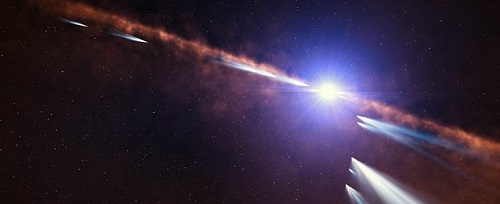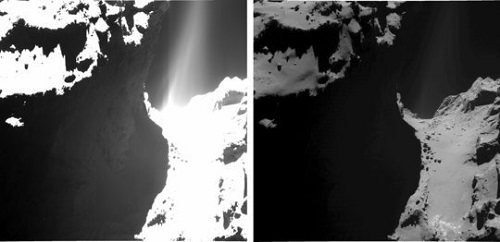Imaging planets around other stars is challenging enough because their light is overwhelmed by the proximity of the parent star. But what about comets? We may not be able to see them directly, but minute variations in light can mark their passage across the stellar disk. Nearly 500 comets have been detected around the star Beta Pictoris using these methods. New work led by Flavien Kiefer (IAP/CNRS/UPMC) analyzes this cometary hoard to give us a look at what is happening in a young planetary system.
Using the HARPS instrument at the European Southern Observatory’s site at La Silla in Chile, Kiefer and team have compiled what the ESO is calling ‘the most complete census of comets around another star ever created.’
Beta Pictoris is becoming an old friend, a young star some 63 light years from the Sun that is no older than 20 million years. The star is surrounded by a disk of material that has been the subject of intense study as we watch the interaction between gas, dust and the asteroids and comets that continue to produce them. Cometary ices evaporate as the comets approach the star, producing the familiar cometary tails we associate with the objects. Usefully, light passing through the released gas and dust can be analyzed to tell us about cometary composition.

Image: An artist’s impression of exocomets around the star Beta Pictoris. Credit: ESO.
Working with data from over 1000 observations obtained between 2003 and 2011, Kiefer’s team produced measurements of the size and speed of the gas clouds and was able to deduce orbital properties for a subset of the comets studied. What emerges is the presence of two distinct families of exocomets, one of them old and showing orbits highly influenced by the massive planet Beta Pictoris b, which was thought to orbit at a distance of one billion kilometers from the star. That number may now be reduced, for the eccentricity and orientation of the comets indicate they are in orbital resonance with an object about 700 million kilometers from the star.
The other comet family is newer and more active, with comets that are all on similar orbits, an indication of a common origin. The likelihood, the researchers say, is that this newer family of exocomets results from the breakdown of a larger object whose remains are now in an orbit that grazes the star. Says Kiefer: “For the first time a statistical study has determined the physics and orbits for a large number of exocomets. This work provides a remarkable look at the mechanisms that were at work in the Solar System just after its formation 4.5 billion years ago.”
The paper is Kiefer et al., “Two families of exocomets in the ? Pictoris system,” Nature 514 (23 October 2014). Abstract available.
An Awakening Comet of Our Own
Meanwhile, a good deal closer to home, the comet 67P/Churyumov-Gerasimenko, under close scrutiny by the Rosetta spacecraft and its OSIRIS imaging system, is showing increasing signs of life. Still more than 450 million kilometers from the Sun, the comet is producing jets of dust along much of its surface, whereas in past months the dust was confined to the ‘neck’ region that connects the two lobes. OSIRIS principal investigator Holger Sierks (MPS) notes that the jets are now appearing on the ‘body’ and ‘head’ of the comet.

Image: Two views of the same region on the “neck” of comet 67P/Churyumov-Gerasimenko. The right image was taken with an exposure time of less than a second and shows details on the comet’s surface. The left image was overexposed (exposure time of 18.45 seconds) so that surface structures are obscured. At the same time, however, jets arising from the comet’s surface become visible. The images were obtained by the wide-angle camera of OSIRIS, Rosetta’s scientific imaging system, on 20 October, 2014 from a distance of 7.2 kilometers from the surface. ESA/Rosetta/MPS for OSIRIS Team MPS/UPD/LAM/IAA/SSO/INTA/UPM/DASP/IDA
We should see much more activity as the comet reaches 300 million kilometers from the Sun and closer. Interestingly, the soon to be renamed ‘Site J’ at the ‘head’ of the comet, designated as the landing site, remains comparatively quiet. Rosetta’s Philae lander will make a landing attempt in November, and we’ll have the opportunity to see an awakening comet close up. Both lander and orbiter are to remain in operation until the comet’s closest approach to the Sun in August of 2015. Keep an eye on the European Space Agency’s Rosetta page for updates.



Wow, exocomets… I had not even thought about whether or not we could detect those, and researchers were taking a census of them around ß Pictoris system for all this time. Possibly the most fascinating scientific adventure our generations are lucky to take a part in is the current remote-sensing and modeling of exoplanetary systems. We are finally getting an idea of how things are for solar systems through the the rest of the cosmos.
I should have been keeping an eye on Rosetta already, ha ha. I wonder what it would be like to stand at Site J in person (in a spacesuit, of course)- would the dust jets be visible to the human eye?
It is interesting that Rosetta is already “sampling” the volatiles from 67P/Churyumov-Gerasimenko. It will be interesting to compare the KBO is that New Horizons will hopefully eventually flyby. One day we should have probes fast enough to flyby an Oort object and analyze pristine cometary material.
When we talk about how to get funding for star flight, it seems possible that we could use early scientific returns from Oort objects as one way to justify funding a flight. It is rather like suggesting that the Voyagers’ earlier planetary flybys were used to justify to return data on the interstellar medium. At 0.03c we could get Oort data from as early as 1 year into the flight and as late as 26 years, which is certainly good enough for a planned robot mission. The returns might then justify a design that would work for a mission to a nearby star. If we wanted to map the stellar medium, we may want to send out many small probes rather than a single large one.
One problem with a mission that returns data ONLY after (say) 500 years is that we don’t have a clue what kind of data scientists then will be interested in (will our science be as outdated as Ptolemy’s?). Hedging our bets make sense. Design a mission that will return data in the near and medium term, and if it can be made to last 500 years and our descendants still find it useful, they’ll keep it going. If not they’ll shut it down. The choice will be theirs but at least we give them the choice.
A system with a lot of comets strikes me as a better colonization candidate than a system with planets. We’re going to have to lick the difficulties in living in space before we colonize other star systems anyway.
Traditionally one of the drivers for interstellar flight was the belief that people would prefer to live on Earth-like worlds rather than in domes or space colonies. If we can build livable/pleasant artificial environments in our own solar system a lot of the incentive for interstellar flight (other than scientific research) goes away.
Oh, I think there are motives that would still exist.
Increasing the number of baskets our eggs are in, and the separation between them, is a good one. Interstellar colonization would make our extinction much less likely.
Political/cultural liberty will be a big driver. Once we have that capacity to build artificial environments affordably, a lot of dissident groups will build them. And some won’t feel secure until they’ve got light years between them and their traditional enemies. Or will figure that around another star, they won’t have to hide in the deep dark.
Groups with big plans. Building a statite array around the Sun could run into some coordination problems. Ditto for a Matrioshka brain or other mega structures. There’s a long list of things that, if you want to do them, you’ll likely have to do them around another star, not this one.
I’m sure this list isn’t exhaustive.
A very precice mass for Beta Pictoris has recently been determined( I THINK it is 1.72 silar masses, but I could be wrong). Therefore, would it be possible to determine the mass and orbital eccentricity of Beta Pic b ( ASSUMING the 700 million km semi-major axis) INDIRECTLY via doppler shifts in the comt tails as they transit? With a sample of 500, it may be posible.
While we wait for Philae to safely make the first landing of a probe on a comet in human history, let us listen to this tribute music to the historic event by none other than Vangelis titled “Arrival”:
http://www.youtube.com/watch?v=FJrUnzLsmZk&feature=youtu.be
The details from YouTube:
Published on Nov 12, 2014
The first of a trio of music videos released by ESA to celebrate the first ever attempted soft landing on a comet by ESA’s Rosetta mission.
Vangelis, the world-renowned musician, has composed this piece of music specially for ESA and inspired by the Rosetta mission. Vangelis’s music is often linked to themes of science, history and exploration, and he is best known for his Academy Award–winning score for the film Chariots of Fire, composing scores for the films Antarctica, Blade Runner, 1492: Conquest of Paradise and Alexander, and the use of his music in the documentary series Cosmos, by Carl Sagan.
Vangelis said: “Mythology, science and space exploration are subjects that have fascinated me since my early childhood. And they were always connected somehow with the music I write.”
Video copyright: ESA/Vangelis
Original music: Vangelis
Follow the Rosetta mission at: http://www.esa.int/rosetta
Also watch:
Part 2: “Philae’s journey” by Vangelis
http://youtu.be/W8bVOGN9jSg
DID PHILAE DRILL THE COMET?
ESA Rosetta Blog – November 19, 2014
Philae’s Sampling, Drilling and Distribution (SD2) subsystem was activated towards the end of the surface operations that Philae performed on Comet 67P/Churyumov-Gerasimenko last week, despite fears that it might alter the lander’s precarious position following its third touchdown. Here we present the latest update from the SD2 team.
SD2’s goal was to drill into the comet surface in order to collect and deliver samples to the COSAC and Ptolemy instruments inside the lander (Click here for our introductory post on SD2). It was the last of the lander’s ten instruments to be operated.
SD2 principal investigator Amalia Finzi has reported that the drill was deployed as planned, extending 46.9 cm below the balcony of the lander and 56.0 cm from its reference point.
“It was then retracted to the reference position, the carousel turned in a way that the sampling tube was in front of the right oven, the discharge operation from the sampling tube to the oven was completed, and the carousel rotated in a way that that oven was positioned at COSAC’s location,” she said.
Although the ovens worked correctly, the scientists do not yet know how much – if any – material was actually delivered to the ovens by SD2, or whether the instruments sampled dust or gas that entered the chamber during the touchdown.
Full article here:
http://blogs.esa.int/rosetta/2014/11/19/did-philae-drill-the-comet/